Digital TSOP lock installation instructions
for 2700, 2800 & 3700 type receivers
(AM29F400B or equivalent TSOP)
|
Introduction
|
Here are step-by-step instructions for the installation of the digital TSOP lock in your receiver. It is fairly simple and can be done in about 15-30 minutes depending on your skills. For best results, take the time to read this carefully and follow the instructions in the order in which they are written here without burning any steps. First, here is a list of tools and supplies you will need:
Small Phillips screwdriver
Power drill
3/16 inch high-speed drill bit
Tape measure or ruler
Felt pen marker (Sharpie)
Soldering iron w/fine tip & resin-core 60/40 solder
28 gauge solid wire (wrap wire)
Wire stripping tool, small long nose pliers, small cutters
Magnifying glass
|
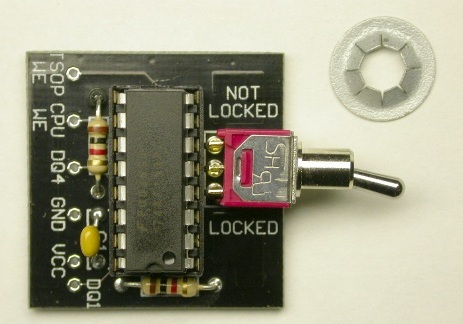
Digital TSOP lock PCB (Printed Circuit Board) shown with special pushnut fastener.
The push nut is required to fasten the board to the back panel on the receiver.
|
1. Drill hole in the back panel of receiver
|
Remove the IRD cover. Use a tape measure or ruler to take measurements and mark the center of the hole to drill with a felt marker. Drill a 3/16" hole 5 1/2 inches from the right-hand side of the receiver case and 1 inch from the top of the receiver case as shown in the picture below.
|
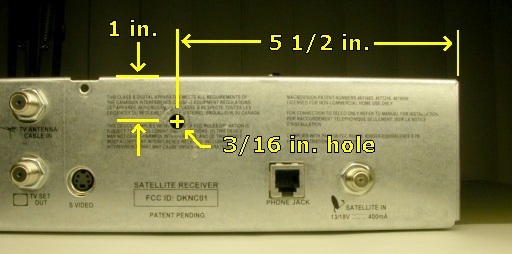
|
TIP:
Turn the receiver upside down and place a small wooden block behind the metal panel while drilling the hole. This will produce a cleaner hole (less burrs on the backside of the hole) and prevent harmful metal chips from going into the receiver. Make sure you clean off any remaining metal particles after drilling since those could cause shorts on the mainboard and seriously damage your receiver.
|
NOTE:
The location and size of hole in the receiver used in the above picture WAS NOT drilled at the size and location specified in this document. Its hole was drilled a long time before this digital lock PCB was designed and this receiver was used only to provide a visual aid. Don't worry if the hole in your receiver looks different from the one in the picture: this is perfectly NORMAL.
|
2. Solder wires to PCB
|
Cut 6 lengths of wrap wire. Make each wire 6 inches long. Strip about 1/8" insulation off one end of each wire and solder all the wires to each of the 6 pad/holes on the front edge of the PCB (DQ1, VCC, GND, DQ4, CPU WE, TSOP WE). It is recommended to insert the wires into the bottom side of the board and solder those from the top side. This is not absolutely required, it just makes for a cleaner looking result.
|
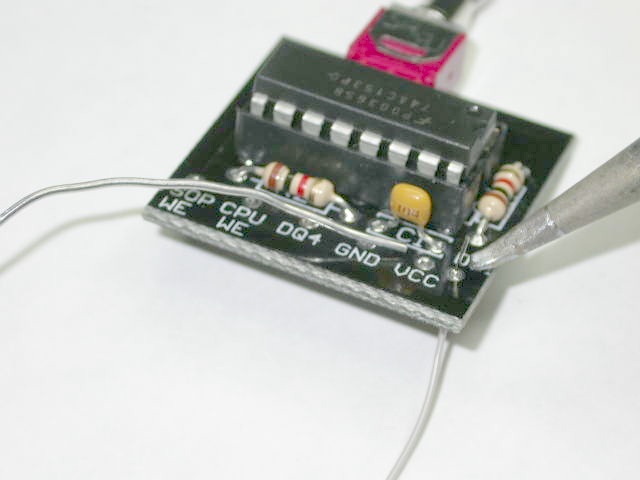
Soldering the wires onto the PCB from the top
|

PCB with all wires soldered on and ready to install in the receiver
|
3. Fasten PCB to receiver back panel
|
Put the PCB's switch lever through the hole from the inside of the receiver. Hold the PCB firmly against the back panel and slide the pushnut over the switch's bushing from the outside of the back panel. The nut is stiff to insert at first and requires a bit of "finger grease". Once it's started, make sure you push on it straight and even as far back as you can.
One method that works well is to use both index fingers to push the PCB against the inside of the back panel while using both your thumbs to push on the edges of the pushnut.
|

Slide pushnut on
|
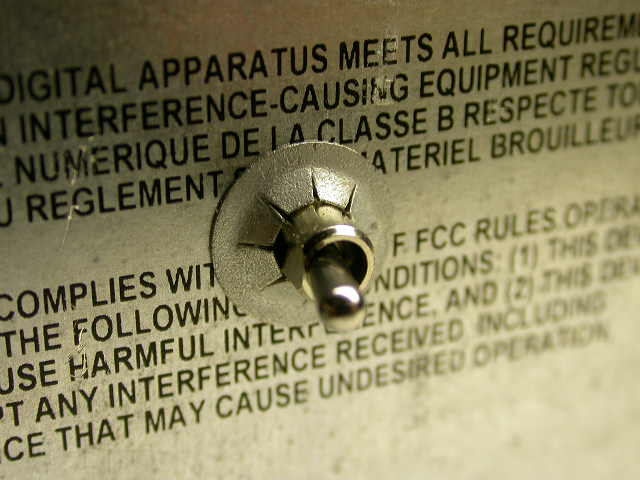
Pushnut fully in
|
4. Remove R259 from the IRD mainboard
|
Locate the surface mount resistor labeled R259 on the mainboard using the picture below as a guide. Remove the resistor by heating up one side with the tip of your iron. The heat will quickly transfer to the other side of the resistor and the solder will melt on both sides. Then simply swipe it off with a lateral motion of your iron.
|
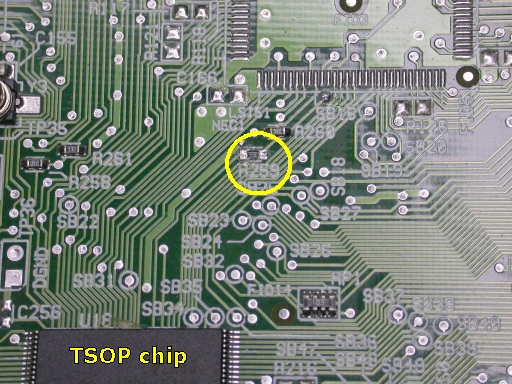
Location of R259
|
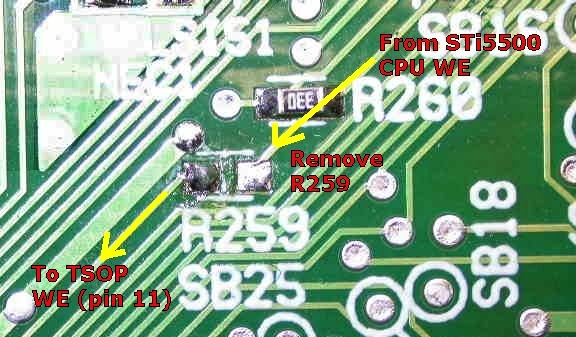
R259 footprint after component is removed
|
TIP:
Don't clean up the solder blobs off the pads unless the solder is shorting the pads together: the residual solder is useful because you will have to solder a wire to the left-hand side pad of R259 later on.
|
NOTE:
There are older versions of the Model 2700 (Model 2710) on which R259 is simply not there. If you have one of those models, you will have to cut the trace where R259 would normally be located. Then solder the CPU WE and TSOP WE wires to the points indicated in the picture below and instead of the points indicated in the subsequent pictures:
|

Cut trace and solder wires on old 2700's
|
5. Locate the wire solder points on the IRD mainboard
|
Locate the wire solder points on the mainboard using the picture below as a guide.
|
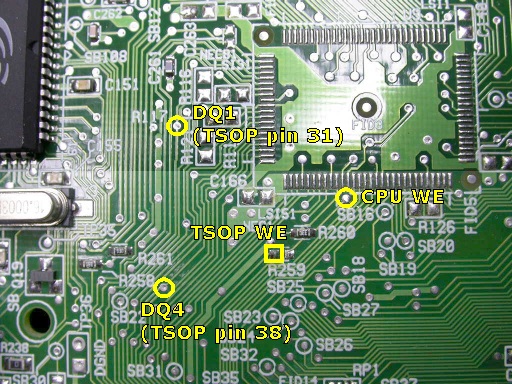
Location of signal solder points
|
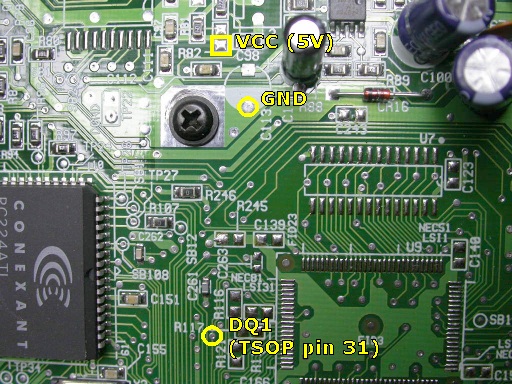
Location of power solder points
|
6. Solder the wires on the IRD mainboard
|
In order for the digital lock circuit to function reliably, it is essential to keep the wires at minimal length. The 6 inch wires already soldered to the PCB at this point should have a bit of excess length and can be shortened. Here's an easy way to trim each wire to its optimal length.
Grab the first wire between your thumb and index and gently pull on it. Let the wire slide between your fingers and place it on the board surface right above the pad where it's meant to be soldered. Leave about 1/4 inch excess length and cut the wire using your fingernail as a marker. Refer to the picture below:
|

How to measure and trim wires for optimal length
|
Next, strip about 1/16 inch insulation off the end of the wire. It's important to strip only a short length of insulation in case you accidentally nick the wire and have to cut the wire and strip it again. It's also a good idea to keep it short because this avoids the wire from potentially shorting to other pads nearby. Here, a good quality wire stripping tool (like the one shown in the picture below) really helps.
|
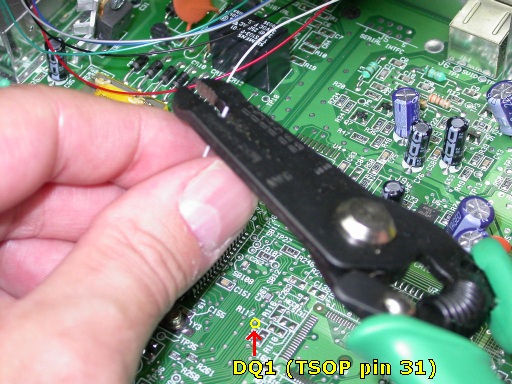
Strip 1/16" of insulation off the end of the wires
|
Now slightly bend the end of the wire about 1/8" above the insulation and hold it above the pad/hole with a pair of fine long nose pliers. With your other hand, heat the edge of the pad with the tip of your soldering iron and push the wire straight down into the hole once the solder melts. Inspect the solder joint with a magnifying glass to make sure it's good. You can also check the solder joint by tugging slightly on the wire. Repeat the operation until all the wires are soldered.
|
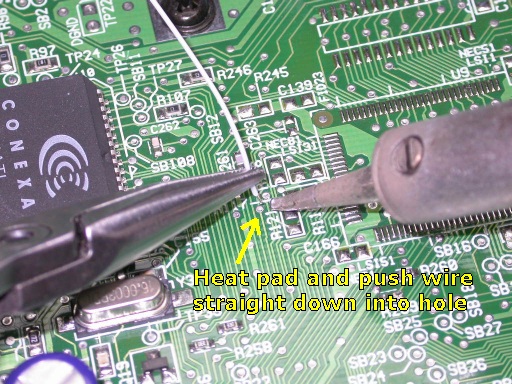
|
NOTE:
The connection points for GND, VCC and TSOP WE are surface mount pads. In plain English, this means that those pads have no holes in them. For those connections, solder the wire flat on the pad instead.
|
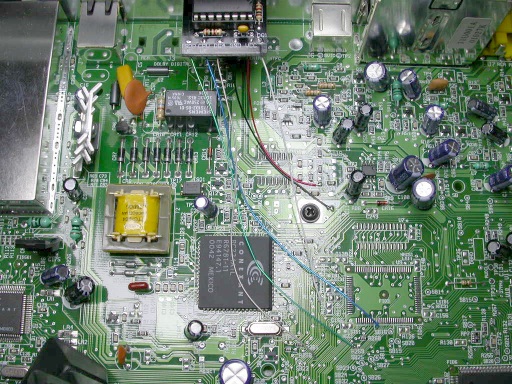
Completed wiring
|
7. Label the TSOP lock switch
|
The final step is to label the lock switch positions on the back panel of the receiver. This is essential in order for the user to be able to tell at a glance whether his TSOP is locked or not. In the picture below, fancy Dymo labels were used but you can simply use a felt pen marker if you want. Just be aware that Sharpie ink markings will come off with alcohol or other solvents. Black pen markings are also harder to read when the receiver is in a dark place (inside a stereo cabinet for example). Printed labels don't have these shortcomings.
|
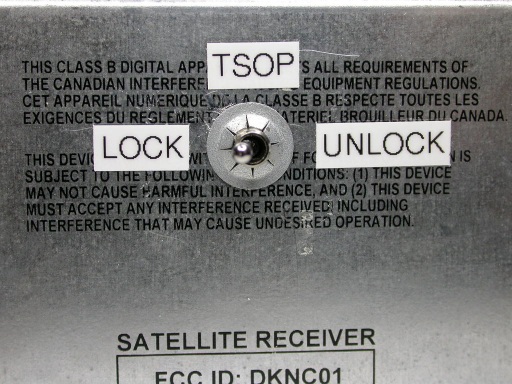
Locked and labeled :-)
|
You're all set. When ECM's come down, you will still get the message "Serious error has occured with your receiver". But the difference is that your TSOP will NOT have been zapped. When that happens, simply pull the card out of the receiver and push it back in. You will be back up and running in a few seconds.
|
Footnote
|
The credit for the logic design of this lock circuit (the schematic) goes to rolesp. However, I designed the PCB layout and came up with the idea of putting the switch directly on the PCB. I'm surprised nobody thought about it before, it seems pretty obvious to me that it's the only way to go. Doing this avoids extra wiring between the board and switch and thus serves several purposes:
- It makes installation easier, both mechanical and wiring
- It avoids potential problems due to excessive wire length
- A toggle switch accessible from outside the IRD makes life easier for the user
It was recommended by rolesp to use a jumper on the board instead of a switch to avoid problems. I completely agree in the case where the switch is NOT on the PCB and extra wiring is required (not the case here). Using a jumper undoubtedly makes the circuit reliable but is kind of impractical since it forces the user to remove the cover of the IRD to access the jumper to take updates from the stream when required. This was not acceptable to me and decided to use a switch instead. So to all those who might have reservations about using a switch instead of a jumper, I can assure you that this board was fully tested and is 100% reliable provided you follow the above instructions to the letter.
|

Tucker
|